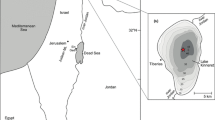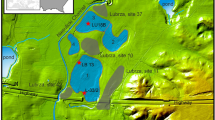Abstract
We reconstruct aspects of the history of Easter Island over the last 4-5 centuries based on the study of a core from Rano Raraku Lake, situated in the crater that contains the quarry of the island's giant statues or moai. We use microfossils of plants and animals to identify five zones. The last three of these are separated by waves of immigration from South America and from the subantarctic. We argue that the first or South American wave, dated to the second half of the 14th century, may represent a visit by South American Indians. Magnetic information, pollen, diatoms, chrysophyte stomatocysts and fossil plant pigments reveal a synchronism between the South American contact and the cessation of moai quarrying. We therefore suggest that Amerindians contributed to the cultural collapse of the island. The second or subantarctic wave may reflect an early European visit to the island, possibly by Cpt. James Cook in 1774, or by Jacob Roggeveen in 1722.
Similar content being viewed by others
References
Arnold, M., M. Orliac & H. Valladas, 1990. Données nouvelles sur la disparition du Palmier (cf. Jubaea) de l'Ile de Pâques. Courier Forsch.Inst. Senckenberg 125: 217–219.
Ayres, W. S., 1971. Radiocarbon dates from Easter Island. J. polyn. Soc. 80: 497–504.
Bahn, P. G., 1996. Making sense of Rongorongo. Nature 379: 204–205.
Bahn, P. & J. Flenley, 1992. Easter Island. Earth Island. Thames & Hudson, London: 240 pp.
Baker, P. E., 1967. Preliminary account of recent geological investigations on Easter Island. Geolog. Mag. 104: 116–122.
Baker, P. E. & F. Buckley, 1974. Petrology and geochemistry of Easter Island. Contr. Mineral. Petrol. 44: 85–100.
Beaglehole, J. C. (ed.), 1961. The Journals of Captain James Cook on his voyages of Discovery. The voyage of the Resolution and Adventure 1772–1775. Cambridge Univ. Press, Cambridge.
Buse, H., 1977. Historia maritima del Peru. Epoca Prehistorica. Tomo II. Volumen 2. Instituto de Estudios Historico Maritimos del Peru. Ausonia, Lima: 987 pp.
Cabello de Balboa, M., 1586. Miscelanea Antartica. Tercera Parte, Capitulo 17, p. 322.
Campos, L. & L. E. Pena, 1973. Los Insectos de la Isla de Pasqua. Rev. chil. Ent. 7: 217–229.
Cocquyt, C., 1991. Diatoms from Easter Island. Biol. Jrb. Dodonaea 59: 109–124.
Desender, K. & L. Baert, 1996. The Coleoptera of Easter Island. Bull. Inst. r. Sci. nat. Belg. 66: 27–50.
Dransfield, J., J. R. Flenley, S. M. King, D. D. Harkness & S. Rapu, 1984. A recently extinct palm from Easter Island. Nature 312: 750–752.
Duff, K. E., M. S. V. Douglas & J. P. Smol, 1992. Chrysophyte cysts in 36 Canadian high arctic ponds. Nord. J. Bot. 12: 479–499.
Duff, K. E., B. A. Zeeb & J. P. Smol, 1995. Atlas of Chrysophycean cysts. Developments in Hydrobiology 99: 189 pp.
Dumont, H. J. & K. Martens, 1996. The freshwater microcrustacea of Easter Island. Hydrobiologia 325: 83–99.
Dumont, H. J. & D. Verschuren, 1991. Atypical ecology of Pantala flavescens (Fabricius) on Easter Island (Anisoptera: Libellulidae). Odonatologica 20: 45–51.
Englert, P. S., 1948. La Tierra de Hotu Matua. Historia, etnologia y lengua de Isla de Pascua. Editorial San Francisco, Padre las Casas, Chile: 533 pp.
Flenley, J. R. & S. M. King, 1984. Late quaternary pollen records from Easter Island. Nature 307: 47–50.
Flenley, J. R., A. S. M. King, J. Jackson, C. Chew, J. T. Teller & M. E. Prentice, 1991. The late quaternary vegetational and climatic history of Easter Island. J. Quat. Sci. 6: 85–115.
Foged, N., 1975. Some littoral diatoms from the coast of Tanzania. Bibl. Phycologica 16: 1–127.
Frey, D. G., 1988. Alona weinecki Studer on the subantarctic islands, not Alona rectangula Sars (Chydoridae, Cladocera). Limnol. Oceanogr. 33: 1386–1411.
Grimm, E. G., 1992. TILIA program users manual. Illinois State Museum, Springfield, Illinois.
Heiser, C. B. Jr., 1974. Totora, taxonomy, and Thor. Plant Sci. Bull.: 22–26.
Heiser, C. B. Jr., 1979. The totora (Scirpus californicus) in Ecuador and Peru. Econ. Bot. 32: 222–236.
Heyerdahl, T., 1952. American Indians in the Pacific: the theory behind the KonTiki expedition. George Allen & Unwin, London.
Heyerdahl, T., 1980. Early man and the ocean. Vintage Books, New York: 438 pp.
Heyerdahl, T., 1989. Easter Island. The mystery solved. Random House, New York: 256 pp.
Heyerdahl, T. & E. N. Ferdon, Jr. (eds), 1961. Reports of the Norwegian Archaeological Expedition to Easter Island and the East Pacific. vol 1. Archaeology of Easter Island. Monogr. School. am. Res. Mus. New Mexico 24: 559 pp.
Kamminga, J. & B. Cotterell, 1984. The pollen record and Easter Island statues. Nature 312: 289.
Korthals, J. J. & C. L. M. Steenbergen 1985. Separation and quantification of pigments from natural phototrophic microbial populations. F.E.M.S.Microb. Ecol. 31: 177–185.
Kuschel, G., 1963. Composition and relationship of the terrestrial faunas of Easter, Juan Fernandez, Desventuradas, and Galapagos Islands. Occ. Pap. calif. Acad. Sci. 44: 79–95.
Martens, K. & F. Behen, 1994. A checklist of the recent non-marine ostracods (Crustacea, Ostracoda) from the inland waters of South America and adjacent islands. Trav. sci. Mus. nat. Hist. nat. Luxembourg 22: 84 pp.
Mulert, F. E. (ed.), 1911. De reis van Mr. Jacob Roggeveen ter ondekking van het Zuidland (1721–1722). Nijhoff, The Hague: 189 pp.
Mulloy, W., 1970. A speculative reconstruction of techniques of carving, transporting and erecting Easter Island statues. Arch.phys. Anthrop. Oceania 5: 1–23.
Oldfield, F., B. A. Maher, J. Donoghue & J. Pierce, 1985. Particle-size related mineral magnetic source sediment linkages in the Rhode River catchment. J. Geol. Soc. Lond. 142: 1035–1046.
Olsson, I. U., 1991. Accuracy and precision in sediment chronology. Hydrobiologia 214: 25–34.
Palmer, J. L., 1870. A visit to Easter Island or Rapa Nui. Proc. r. Geog. Soc. Lond. 14: 108–119.
Reyss, J. L., S. Schmidt, F. Lejelux & P. Bonte, 1995. Large, low background welltype detectors for measurements of environmental radioactivity. Nuclear Instruments Methods A 357: 311–317.
Sarmiento de Gamboa, P., 1572. Historia de los Incas (Segunda parte de la Historia General llamada Indica). Cap XLVI: 215–216.
Segers, H. & H. J. Dumont, 1993. Zoogeography of Pacific Ocean islands: a comparison of the rotifer faunas of Easter Island and the Galapagos archipelago. Hydrobiologia 255/256: 475–480.
Skottsberg, C., 1956. Derivation of the Flora and Fauna of San Juan Fernandez and Easter Island: the natural history of Juan Fernandez and Easter Island. Vol 1: 438 pp. Almquist & Wiksells, Uppsala.
Smith, C. S., 1961a. A temporal sequence derived from certain Ahu. In Y. Heyerdahl & N. Ferdon Jr. (eds), q.v.: 118–120.
Smith, C. S., 1961b. Radiocarbon dates from Easter Island. In T. Heyerdahl & N. Ferdon Jr. (eds), q.v.: 393–396.
Steadman, D. W., 1995. Prehistoric extinctions of Pacific Island birds: biodiversity meets zooarchaeology. Science 2667: 1123–1131.
Stuiver, M. & P. J. Reimer, 1986. Computer program for radiocarbon age calibration. Radiocarbon 28 (2B): 1022–1030.
Zeeb, B. A. & J. P. Smol, 1993. Chrysophycean stomatocyst flora from Elk Lake, Clearwater County, Minnesota. Can. J. Bot. 71: 737–756.
Author information
Authors and Affiliations
Rights and permissions
About this article
Cite this article
Dumont, H.J., Cocquyt, C., Fontugne, M. et al. The end of moai quarrying and its effect on Lake Rano Raraku, Easter Island. Journal of Paleolimnology 20, 409–422 (1998). https://doi.org/10.1023/A:1008012720960
Issue Date:
DOI: https://doi.org/10.1023/A:1008012720960




